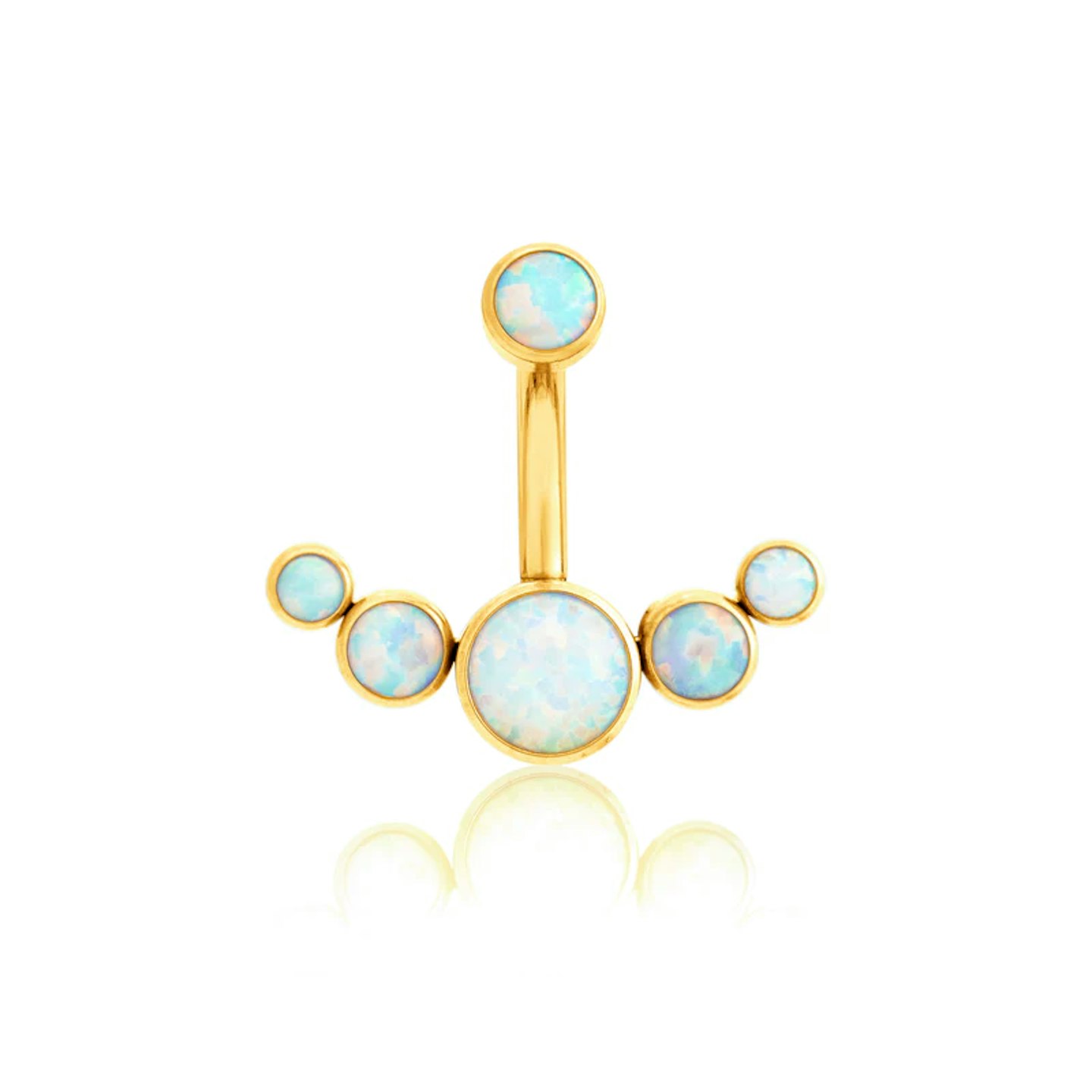Apparently, as a society we’re pretty keen on belly button piercings. They dominated the noughties, thanks to the likes of Britney Spears and Christina Aguilera circa 2000, but their popularity has by no means remained stuck in the past. Today, everyone from Megan Thee Stallion to Miley Cyrusand Vanessa Hudgensstill bedazzle their midriff with the sparkly accessory, giving us more reasons to consider belly button piercings for ourselves.
Belly buttons were the early noughties piercing of choice.Just like septum rings are the de rigueur right now, back then the humble belly piercing was in its heyday. Hell, even Will Young used to have his belly button pierced – he wore a hoop in it, I might add.
If you've toyed with the idea of investing in the A-list's favourite noughties accessory, there's a few considerations to make before you take the plunge: Does a belly button piercing hurt? How much does a piercing cost? How old do you have to be to get a belly button piercing? And, crucially, what on earth counts as a classy belly button piercing? The same questions arise for any type of piercings whether that be ear piercings or ever-cool nose piercings. Happily, help is at hand. Jasmine Lloyd, body piercer at trendy South London tattoo parlour Rye Lanez and Nicole Mitchell resident piercer at hip central London fine jewellery piercing shop Sacred Gold's have performed hundreds of belly button piercings between them. Who better then to answer all those burning questions like, how long does a belly button piercing take to heal? Read on to ensure that you're fully versed on all things belly button piercing.

Belly Button Piercing: The Low Down
So, what actually is a belly button piercing? The pro's refer to it as a navel piercing, and it usually involves a piece of jewellery being inserted through the bit of skin - which Lloyd tells me is 'known as the shelf, or lip' in the piercing bizz - that lies directly above the belly button. That means the accessory will hang slightly over the belly button by nature.
Though not as common, you can also find belly button piercings on the lower rim, upper rim, and sides of the navel. 'The top is the the most popular,' says Lloyd but sometimes that's not the best place for someone to get pierced. 'If somebody doesn’t have suitable anatomy for a regular navel piercing - for example, their skin it too tight, or they don’t have enough of a ‘shelf’ to pierce, they potentially could be more suited for a floating navel, or a lower navel,' explains Lloyd.
There are a few people who might not be suitable for a belly button piercing. Most piercing shops recommend waiting until you have fully grown before you invest in a belly button piercing and won't perform a piercing until you are at least 16 years old. 'This is in case the navel anatomy changes as you grow,' points out Mitchell. Been blessed with an outie? 'Chances are you cannot get a navel piercing,' confirms Mitchell. On the flip side, 'if you have a very deep navel, you will most likely be suitable for what we call a floating navel piercing,' says Mitchell. 'This means the traditional double gemmed bar is not suitable, and a curved barbell with flat disc or small bead on the bottom is used instead. The top of the bar can be adorned with a decorative end like a flat gem or design.'
What To Expect At A Belly Button Piercing Appointment
The entire process takes no longer than ten minutes from assessment to walking out with a beautifully adorned belly button. However, know that the type of piercing procedure is entirely dependent on where you go. Mitchell is a fan of using a 'single use sterilised needle,' and tends to perform a belly piercing freehand. 'That means no tool is used to hold the navel, only the fingers are used to brace and manipulate the tissue.' According to the pros, piercing freehand 'allows more control to achieve the correct depth, and cause less trauma to the area.' Lloyd, on the other hand, prefers to use a clamp before piercing with the needle.
Pre-piercing you can expect to have your belly button examined in ways its never been examined before. 'Your piercer will perform an anatomy check first,' explains Mitchell, 'which is checking to see if your navel is the right shape, size and that you have enough space for the jewellery to sit. You will be checked standing, sitting, and lying down, so we can see how your navel changes shape as you move. If the navel closes completely and folds over when you sit down, you may not have the correct anatomy. Marking for the piercing placement is done with the client standing up straight, and the piercing is done with the client lying down flat.'
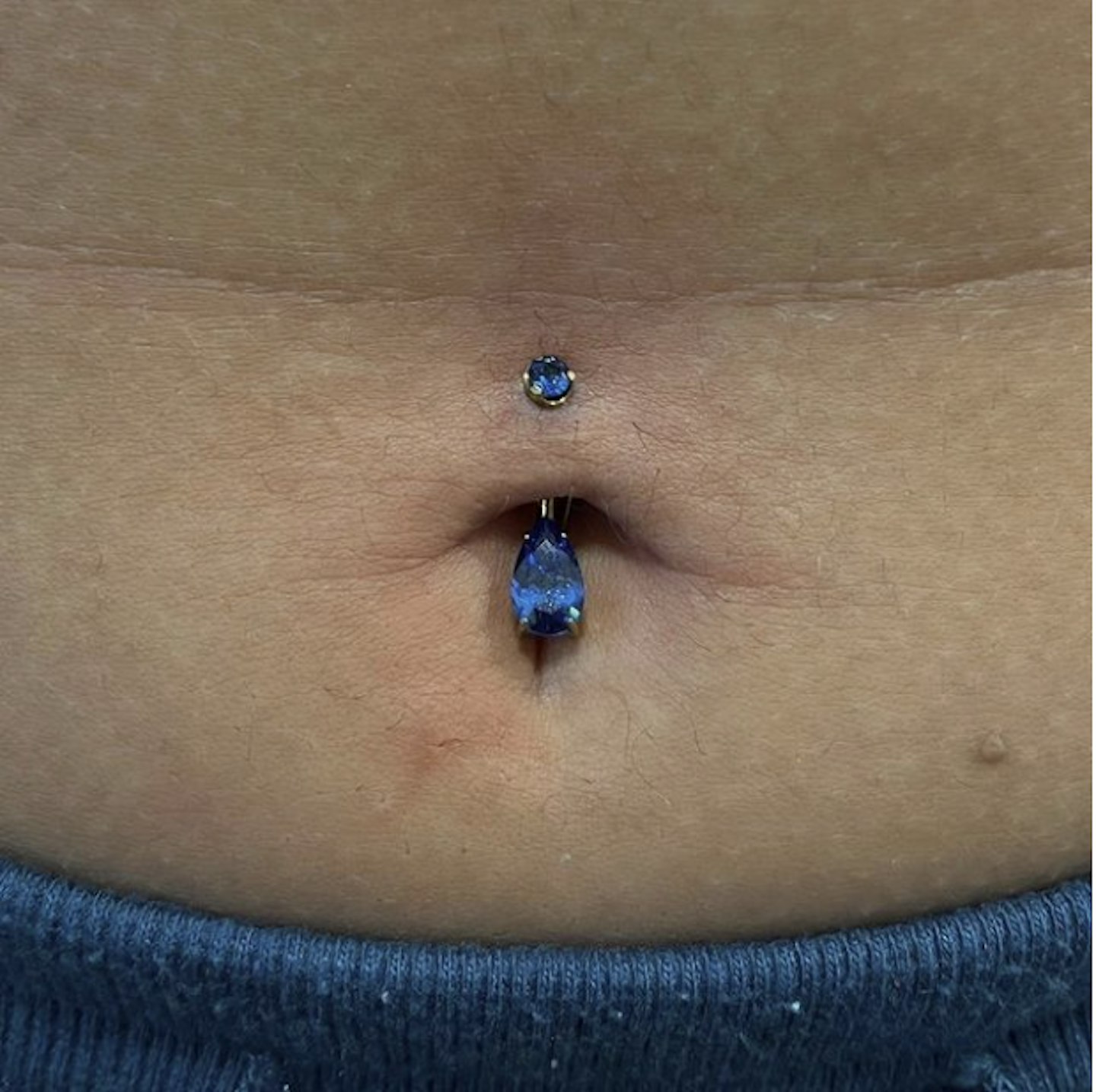
Does getting a belly button piercing hurt?
I know, I know, it always sounds like such a yarn when people say this but it actually doesn't. The most painful part is usually the pinchy clamp (if used) they put on before putting the needle through. Both Lloyd and Mitchell are quick to point out that numbing cream is really not necessary. ' The piercing is over quickly with a small sharp pinch. Usually it takes a few seconds to do the piercing and insert the jewellery,' says Mitchell. That said, pain threshold works on a case by case basis, so the levels of pain will always vary from person to person.
Typically there should be no bleeding with this type of piercing but you can expect the area to be a little swollen and red. Any redness should disappear after a day or so but swelling can last for the next few weeks.
Wondering how long a belly button piercing takes to heal? With the correct aftercare it's usually around six months although some people may find it takes up to a year before it's fully healed.
The best jewellery materials for belly button piercings
A good rule of thumb is to opt for the highest grade metal possible. 'Lower quality metals, such as surgical steel, also sterling silver and 9 ct gold, can cause reactions due to being mixed with other metals,' explains Lloyd, 'this can really hinder the healing, and irritate the piercing.' Lloyd always pierces with ASTM F136 Implant grade titanium or certain solid gold if the supplier 'can guarantee the exact components of the metal.' For Mitchell it's a similar story. 'We use implant grade titanium and solid 14k gold in our studios. These materials are biocompatible and safe for people with metal allergies.'
Surgical Stainless Steel: This is one of the most common materials used for body piercings. It is hypoallergenic, durable, and resists corrosion, making it an excellent option for initial piercings.
Titanium: Another hypoallergenic and lightweight option is titanium. It is non toxic and suitable for individuals with metal allergies or sensitive skin.
Niobium: Similar to titanium, niobium is also hypoallergenic and lightweight. It's a good alternative for those with metal sensitivities.
14k or 18k Gold: High-quality gold jeweller(not gold-plated) is a good pick especially if you want a touch of elegance.
Implant-Grade Bioflex or Bioplast: These are flexible materials that can reduce irritation and are particularly useful during the initial healing period.
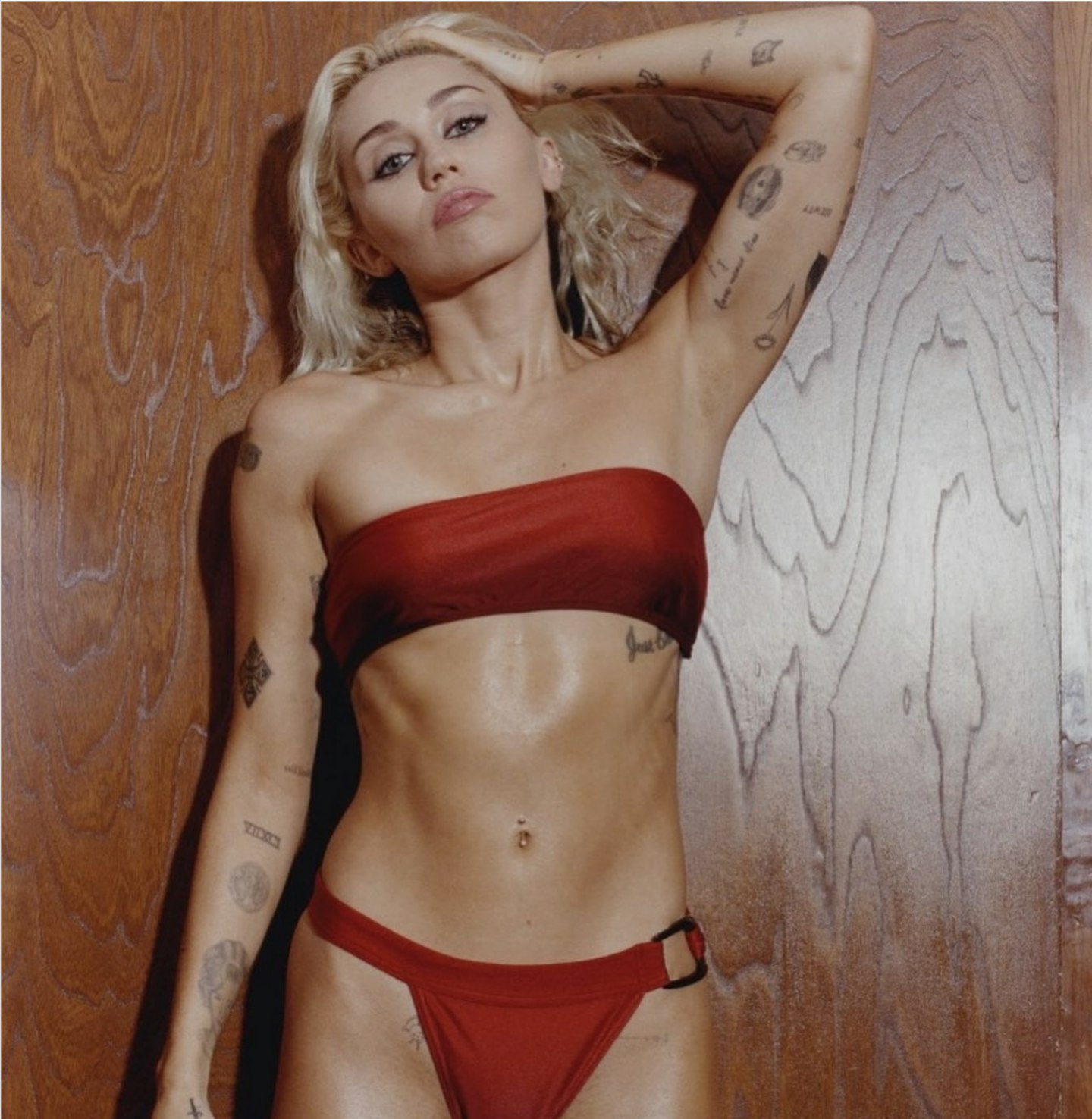
Choosing Belly Button Piercing Jewellery
Of course the most important thing is to choose something you like. According to Lloyd, most people tend to opt for something 'sparkly and not too big' when they initially get pierced. And she advises to avoid getting anything dangly or a ring initially in case it gets caught and interrupts the healing process.
The most popular belly button piercing jewellery include classic navel curves (with a decorative gem on top and bottom), plain curves (with beads either end which can be customised with flat discs or small beads to fit your anatomy better) and plain bars with a decorative tops which are a good choice for flowing navels as they sit flat against the skin. Belly rings are having a moment too. 'I have found that rings are becoming more popular recently for healed navel piercings,' confirms Lloyd.
It's important to consider your lifestyle when choosing a belly button piercing. If you're somebody that is very active, 'you need to take extra care when bending and stretching while it heals,' warns Mitchell. And, make sure that you 'clean it after exercising so sweat does not build up in the navel.' Gross, but crucial. Conversely, if you sit down all day at work trying to avoiding wearing high waisted clothes so that they don't rub or catch on the piercing.
Pregnant? You'll probably find you need to remove the jewellery to accommodate for the skin stretching. The good news is that the piercing typically stays open forever so once the pregnancy is over you can re-jewel, if you so wish.
Talking of forever, belly button piercings can be kept in as long as you desire. However, Mitchell says one thing to note is that 'sometimes as the years go by the piercing can migrate, which means the placement of the piercing can get shallower.' If this happens check in with your piercer so better fitting jewellery can be inserted.
Shop: Belly button piercing jewellery
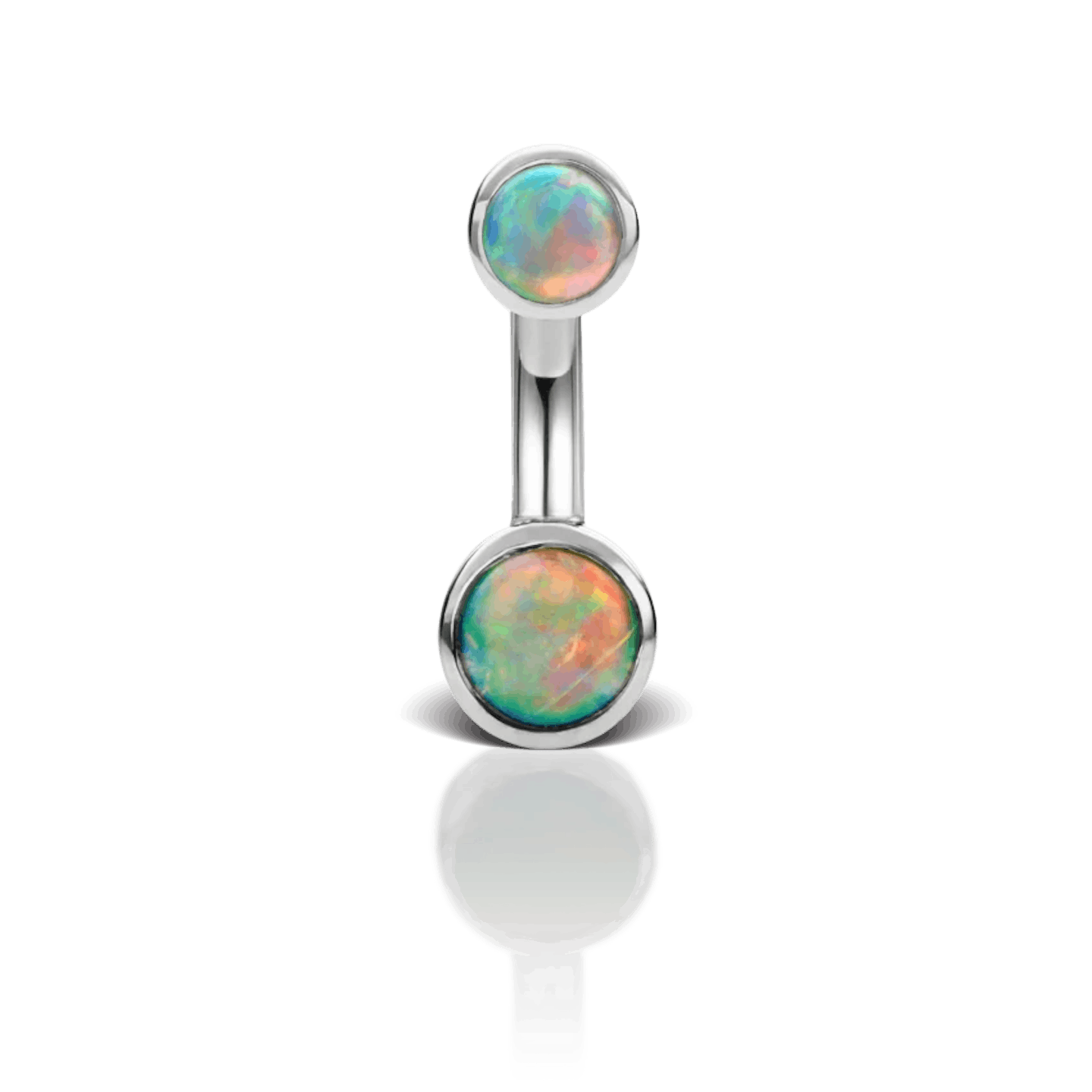 Maria Tash
Maria Tashwww.mariatash.com
A solid gold and natural Australian opal cup set navel barbell. The bottom sizeable gemstone will provide moderate coverage for most navel openings. The stones glow in a kaleidoscope of colour and are hand-picked and matched in tone for each piece.
Pros
- Solid Gold
Cons
- Subtle not statement
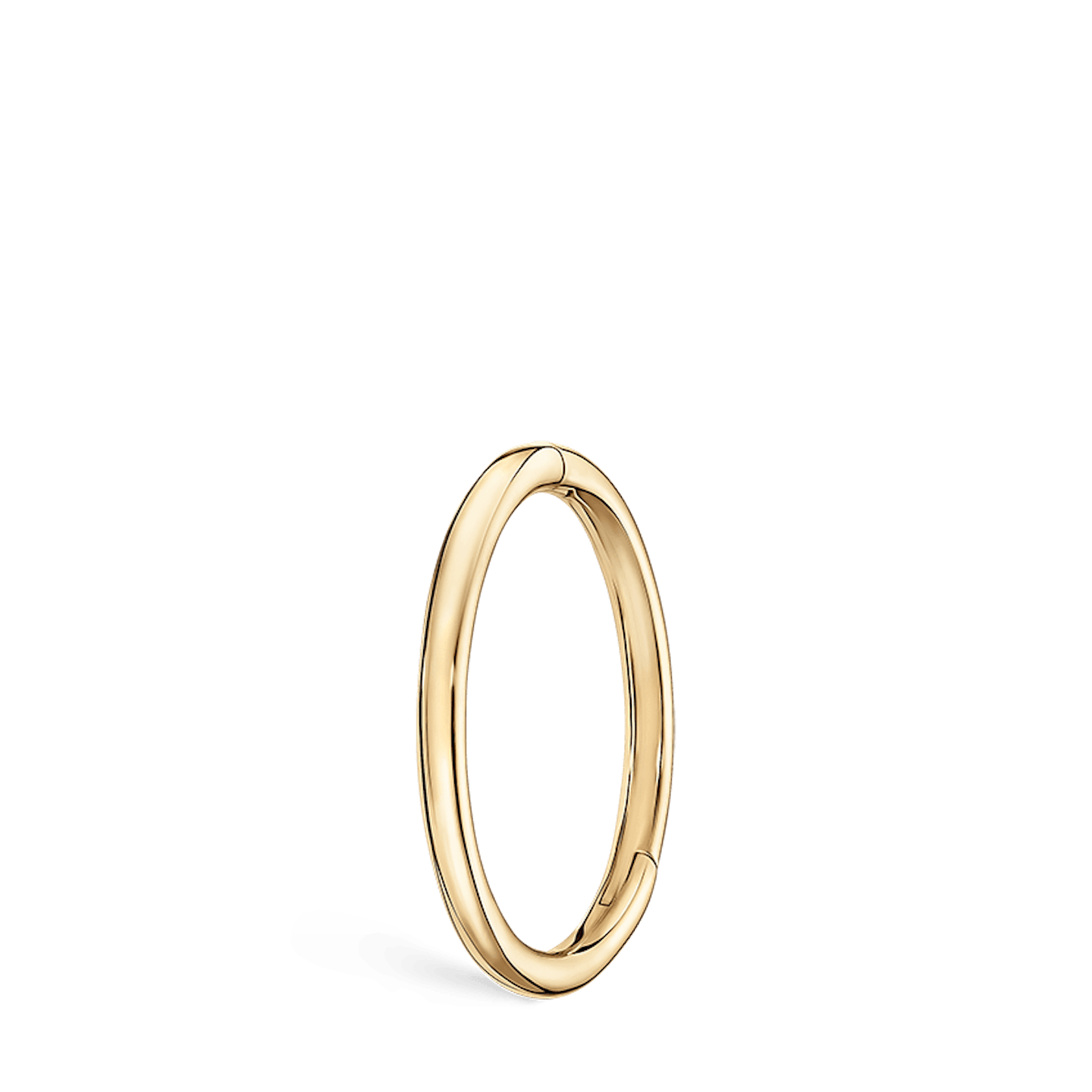 Maria Tash
Maria Tashwww.mariatash.com
An earring in your tummy? Go on then. Belly button hoops are having a moment. They're chic, they're sophisticated, they're not a butterfly charm. Available in a wide range of sizes, this solid gold ring is perfect for those who want a sleek look. The clicking mechanism makes it easy to insert and remove. And, if you really can't resist something sparkly, you can add a charm to the hoop. Cute.
Pros
- Solid gold
- Can add charms
Cons
- Might get caught in high waisted clothing
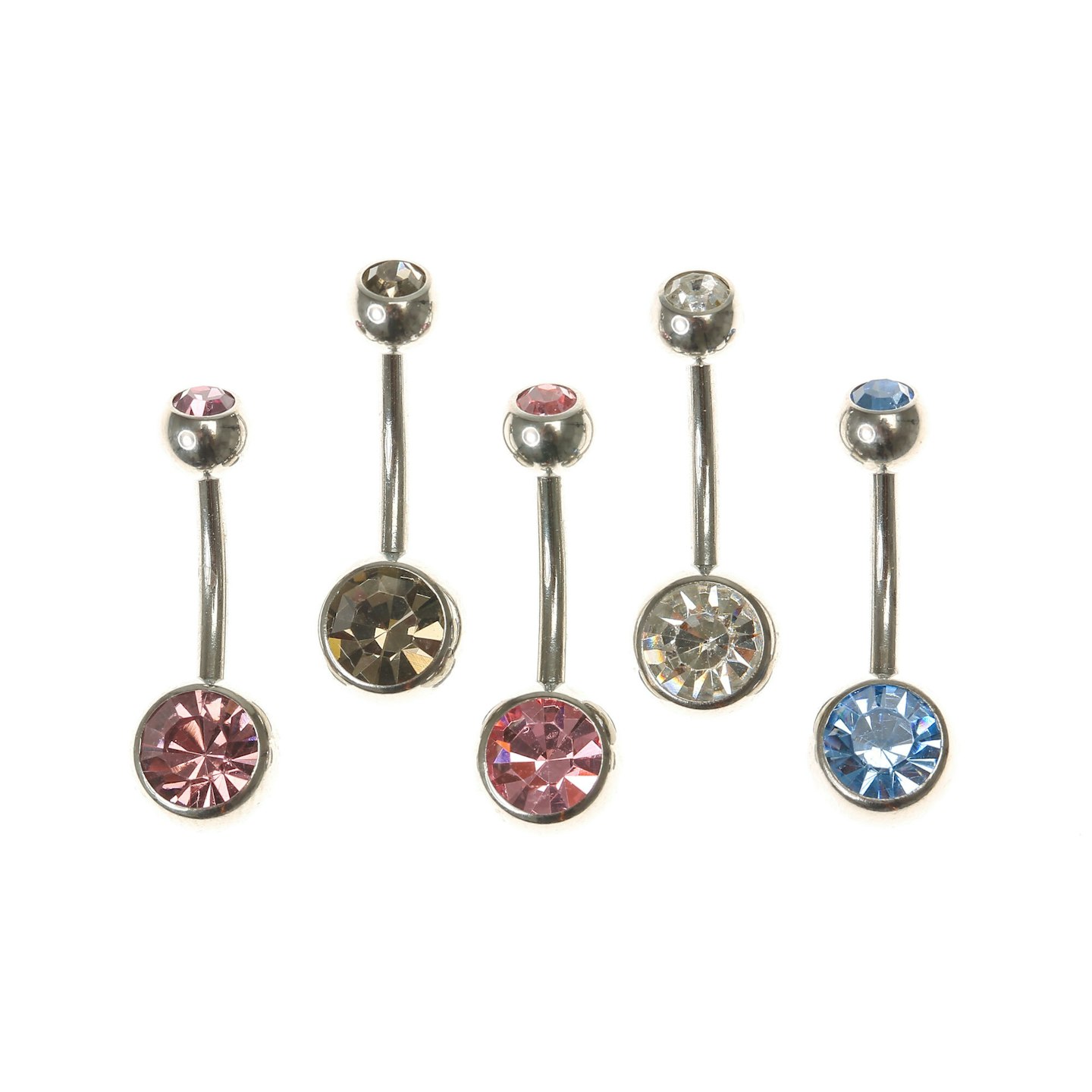 Claire's
Claire'swww.claires.com
The OG belly rings, this is what I call entry level into body gems. Change your belly ring every day, because why not? Add some lovely pastel colours to your body jewelry with these belly rings! This set includes a belly ring with faux crystal stones in baby blue, dusty rose, baby pink, yellow, and clear.
Pros
- Different colour for a different day
- Easy to put in and remove
Cons
- Not high grade metal
The Aftercare
Keeping your new piercing clean is essential. Do this with saline soaks which can be made using half a teaspoon of sea salt with a pint boiled water, let it cool before using it. This works great as salt promotes healing and helps fight infections. If you aren't keen on making your own, you can use Stericlens, £7.40, or [Neilmed, £13.41]{href='https://www.amazon.co.uk/NeilMed-NeilCleanse-Piercing-Aftercare-Fluid/dp/B00TZUJW6O/ref=sr_1_4?tag=qbauermedia-21' target='_blank' rel='noreferrer noopener' class='add-referrer-link'}, sprays. And, take heed of Lloyd's advice when she says, 'it's really important to avoid high waisted clothing, swimming, and touching it in the initial healing stages.'
Signs of infection
Like any other body piercing, your belly button piercing can become infected if not properly cared for. Here are some common signs of infection:
-
Discharge - If you notice yellow, green, or brownish discharge coming from the hole it is likely infected.
-
Tenderness - Some discomfort is expected after getting a piercing, but if the pain intensifies it could be a sign of infection.
-
Swelling - Mild swelling is common during the initial healing period of a piercing, but if the swelling worsens or persists, it could indicate an infection.
-
Redness - The area around the piercing might look more red than usual. This can be a sign of inflammation and potential infection
-
Rejection - You do also have the risk of the piercing rejecting. This is why it's important your piercer checks you're a suitable candidate before piercing. 'If the piercing is excessively rubbed or caught badly during the healing process, it is possible the piercing could reject which would result in scarring in the area,' warns Mitchell. However, 'even with the right anatomy, a professional piercer, and perfect aftercare, this unfortunately can still happen,' warns Lloyd. If you suspect your piercing is being rejected check in with your piercer as soon as possible.
Does getting a belly button piercing look good?
Yes, because it draws the eye in - AKA it makes you look leaner. It’s simple science: the eye is drawn to the piercing so your stomach automatically looks flatter. Trust me, I’ve taken it out many a time, wondering if I should get rid, then realise my food baby is way smaller (and prettily decorated) when I’ve got it in. Who needs paleo when you’ve got a belly piercing?
Belly buttons are easy to cover up
Just like having your nipples pierced (but waaaay less painful, I’ve heard), no one knows about it unless you tell/show them/Instagram it, so it’s your little secret! It’s sort of like when you work on your pelvic floor strength during a conversation, but no one knows but you. Don’t ask how that’s the only metaphor I could come up with.
How to style belly button piercings
Wearing a crop top is when the belly-bar really comes into its own. Anyone can wear a blimmin’ crop top, but only you can go one better and show off your body jewellery in the process. All other crop-top wearers cower in your brilliance.
It’s what you make it, people! The belly-bar is not in itself cheap or naff. It only becomes that when you start wearing jewellery shaped like an arrow pointing to your crotch with ‘Heaven’ written on it. Or with about three stones worth of cubic zirconia dangling from it.
So leave the belly bar out of it; this blame falls to the owner. I, for one, prefer an understated, gold hoop because I’m an understated kinda gal.
How do I take out my belly piercing?
Leave the original piercing in for at least six to nine months, depending on the healing process. Many piercers recommend going back the piercing studio to take out your piercing but it is also safe to do so at home, once fully healed - always wash your hands before touching the piercing. To remove, the top of belly button piercing is usually attached with a ball, unscrew this and allow the piercing to fall out before putting in your new belly bling.
Can You Go Swimming After A Piercing?
Not until it's healed people. The official NHS advice is to avoid swimming until at least 24 hours after you've had a new piercing, and ideally until it's fully healed. And, Mitchell reiterates the importance of 'keeping your piercing really dry after swimming or showering, to help mitigate the chances of an infection.'
How Much Do Belly Button Piercings Cost?
The price of getting your tummy pierced varies from place to place and depends on what jewellery you opt for. Expect to pay anything from £35+. Maria Tash at Liberty Londoncharges £37 for naval piercings, as well as nipple piercings.
READ MORE: Nose Piercings, Everything You Need To Know
READ MORE: Helix Piercings Are In: Here's Everything You Need To Know
READ MORE: Ear piercings: Your Definitive Guide
Like this? Then you may be interested in:
All The Jewellery You Bought From Claire’s Accessories Back In The Day
Verity Clark is Grazia's Acting Health & Beauty Director where she covers all things health, beauty and wellness related.


